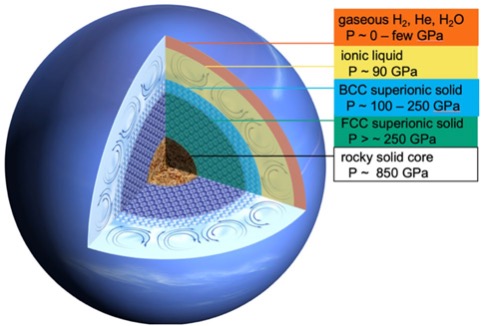Unusual Ice Variant Discovered, Resistant to Melting Except at Extremely High Temperatures
Inside planets, peculiar phenomena occur due to the combination of intense pressures and high temperatures. Within Earth’s solid inner core, it is believed that iron atoms engage in a unique dance. Additionally, the gas giants Uranus and Neptune likely harbor a peculiar form of ice known as superionic ice, which is simultaneously solid and liquid. Scientists successfully replicated this exotic ice in laboratory experiments five years ago, and its existence and crystalline structure were confirmed four years later.
Recently, researchers from various universities in the United States and the Stanford Linear Accelerator Center laboratory in California made a groundbreaking discovery. They identified a new phase of superionic ice, further enhancing our comprehension of the irregular magnetic fields with multiple poles observed in Uranus and Neptune.
Contrary to the conventional perception of water as a simple molecule with an elbow-shaped structure, consisting of one oxygen atom bonded to two hydrogen atoms that remain fixed in position when frozen, superionic ice exhibits remarkable dissimilarities. Despite its peculiar nature, it is speculated that superionic ice may be one of the most prevalent forms of water in the Universe, potentially filling the interiors of not only Uranus and Neptune but also similar exoplanets.
These celestial bodies endure extreme pressures, reaching 2 million times that of Earth’s atmosphere, and possess interiors as scorching as the Sun’s surface. It is within these extreme conditions that water exhibits its extraordinary behavior.

In 2019, scientists confirmed what physicists had predicted in 1988: the existence of a solid cubic lattice structure in superionic ice, where oxygen atoms are locked while ionized hydrogen atoms flow freely like electrons in metals. This unique arrangement gives superionic ice its conductive properties and allows it to remain solid at extremely high temperatures.
In a recent study conducted by physicist Arianna Gleason and her colleagues at Stanford University, thin slices of water were bombarded with powerful lasers between two diamond layers. The resulting shockwaves increased the pressure to 200 GPa and temperatures of about 5,000 K, surpassing the conditions of previous experiments in 2019 but at lower pressures.
The purpose of this study was to gain a better understanding of the phase diagram of water under extreme pressure and temperature conditions, which is relevant to the interiors of water-rich exoplanets similar to Neptune. Gleason and her team explained this in their paper from January 2022.
Through X-ray diffraction, the researchers were able to determine the crystal structure of the hot and dense ice, despite the short duration of the pressure and temperature conditions. The diffraction patterns confirmed that the ice crystals belonged to a new phase called Ice XIX, distinct from the superionic ice observed in 2019. Ice XIX has a body-centered cubic structure and exhibits higher conductivity compared to its predecessor, Ice XVIII.
This discovery of a new phase of superionic ice has significant implications for our understanding of the properties and behavior of water under extreme conditions, particularly in the context of exoplanets. Further research in this field will undoubtedly shed more light on the fascinating nature of water and its various forms.
The significance of conductivity lies in its ability to generate magnetic fields through the movement of charged particles. This principle forms the foundation of dynamo theory, which explains how magnetic fields are created by the turbulent flow of conductive fluids, such as the Earth’s mantle or the interior of other celestial bodies.
If a larger portion of the interior of an ice giant resembling Neptune were composed of a semi-solid substance, with a smaller portion consisting of a swirling liquid, it would result in a different type of magnetic field being produced.
Furthermore, if this planet possessed two superionic layers with varying conductivity towards its core, as proposed by Gleason and colleagues for Neptune, the magnetic field generated by the outer liquid layer would interact with each superionic layer in distinct ways, further adding to the complexity of the situation.

The publication in Scientific Reports by Gleason and his team suggests that the increased conductivity of a superionic ice layer similar to Ice XIX could potentially lead to the creation of irregular, multipolar magnetic fields similar to those observed in Uranus and Neptune. This finding would be significant, especially considering that it has been over 30 years since NASA’s Voyager II spacecraft passed by these icy giants in our Solar System and detected their remarkably unique magnetic fields.
This article is republished from sciencealert under a Creative Commons license. Read the original article.
Do not forget to share your opinion with us to provide you with the best posts !




0 Comments